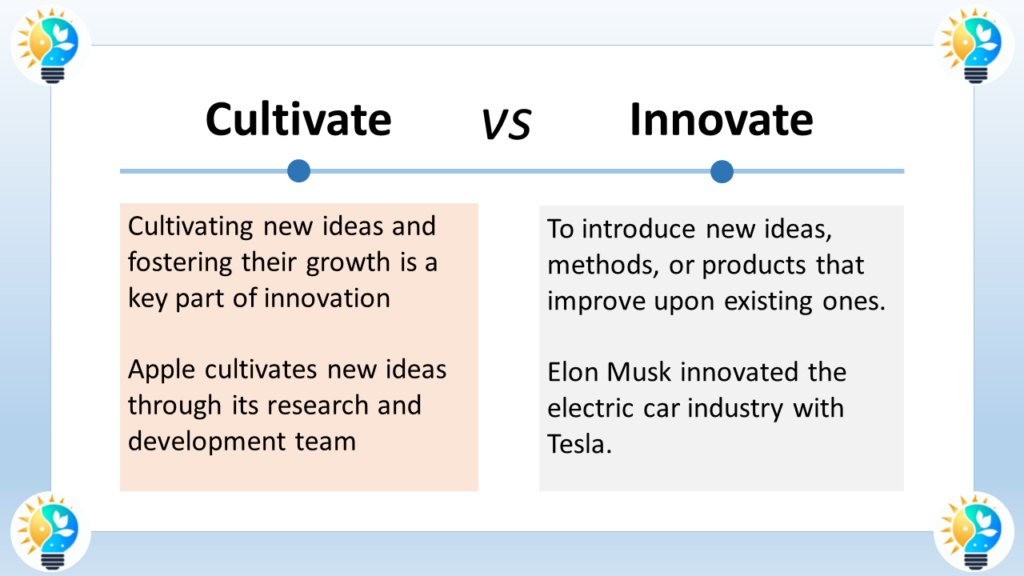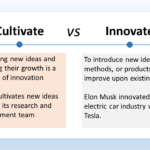
Cultivating involves nurturing and improving existing ideas, while innovating involves introducing new ones. Cultivating is a slower and more gradual process, while innovating can involve rapid change.
The Intersection of Innovation and Cultivation: A Symbiotic Relationship
The terms innovation and cultivation are often used interchangeably.
While innovation refers to the development of new ideas, products, or methods, cultivation is the process of nurturing and growing those ideas to their full potential.
Definitions of Innovation vs Cultivation
Innovate: To introduce something new, such as an idea, method, or product. Innovation involves creating or improving existing products, services, or processes to add value to society.
Cultivate: To develop or improve something through careful attention and nurturing. Cultivation involves fostering growth and sustainability by providing the necessary resources and support. In the context of business, cultivation often refers to the process of nurturing an innovative idea into a successful product or service.
More Synonyms on innovation, innovate and innovative:
- Adapt
- Advance
- Change
- Create
- Cultivate
- Devise
- Develop
- Discover
- Disrupt
- Evolve
- Experiment
- Fashion
- Generate
- Imagine
- Initiate
- Introduce
- Invent
- Modernize
- Originate
- Pioneer
- Progress
- Prototype
- Radicalize
- Reform
- Reinvent
- Renew
- Revolutionize
- Restructure
- Set Trends
- Transform
- Upgrade

Innovation is considered as a driving force in progress.
It includes the introduction of novel ideas, methods, or products that bring positive change and advancement.
For more information about innovations, check our glossary
The Role of Innovation
Innovation is the driving force behind progress. It is the process of creating something new that adds value to society. Innovation can take many forms, including new products, services, processes, or business models. Innovation is essential for businesses to stay competitive and relevant in today’s rapidly changing marketplace.
The Importance of Cultivation
Cultivation, on the other hand, is the process of nurturing and growing those innovative ideas. It involves developing strategies, building teams, and creating a culture that fosters growth and sustainability. Cultivation is critical for turning innovative ideas into successful products or services.
The Intersection of Innovation and Cultivation
While innovation and cultivation are distinct concepts, they are interconnected. Innovation without cultivation is like planting a seed without watering it. Without the proper care and attention, the seed will not grow into a healthy plant. Similarly, cultivation without innovation is like watering a dead plant. No matter how much care and attention you provide, the plant will not grow if it is not alive.
The Benefits of Combining Innovation and Cultivation
When businesses combine innovation and cultivation, they can create a powerful force for growth and success. By fostering a culture of innovation and providing the resources and support necessary for cultivation, businesses can create a sustainable competitive advantage.
Creating a Culture of Innovation
Creating a culture of innovation is essential for businesses that want to stay ahead of the curve. This involves encouraging employees to think creatively and take risks. It also means providing the resources and support necessary for employees to develop and test new ideas.
Building a Team for Cultivation
Building a team for cultivation is just as important as creating a culture of innovation. This team should be responsible for developing strategies, building partnerships, and creating a roadmap for growth. The team should also be responsible for measuring the success of the innovation and making necessary adjustments.
The Role of Technology in Innovation and Cultivation
Technology plays a critical role in both innovation and cultivation. It provides businesses with the tools they need to develop and test new ideas quickly and efficiently. It also allows businesses to collect and analyze data, which is essential for making informed decisions about the growth and sustainability of the innovation.
Challenges in Combining Innovation and Cultivation
While combining innovation and cultivation can be a powerful force for growth and success, it is not without its challenges. One of the biggest challenges is balancing the need for speed and agility with the need for strategic planning and long-term sustainability. Businesses must also be willing to take risks and embrace failure as an essential part of the innovation process.
Conclusion
Innovation and cultivation are two distinct concepts that have a symbiotic relationship. By fostering a culture of innovation and providing the resources and support necessary for cultivation, businesses can create a sustainable competitive advantage. While there are challenges in combining innovation and cultivation, the benefits far outweigh the risks. By embracing both concepts, businesses can drive growth, stay ahead of the curve, and create value for society.
FAQs
- What is innovation?
Innovation is the development of new ideas, products, or methods that add value to society.
- What is cultivation?
Cultivation is the process of nurturing and growing those innovative ideas to their full potential.
- Why is cultivation important for innovation?
Cultivation is critical for turning innovative ideas into successful products or services. Without cultivation, innovative ideas may never reach their full potential.
- How can businesses create a culture of innovation?
Businesses can create a culture of innovation by encouraging employees to think creatively, taking risks, and providing the resources and support necessary for employees to develop and test new ideas.
- What role does technology play in innovation and cultivation?
Technology provides businesses with the tools they need to develop and test new ideas quickly and efficiently. It also allows businesses to collect and analyze data, which is essential for making informed decisions about the growth and sustainability of the innovation.


